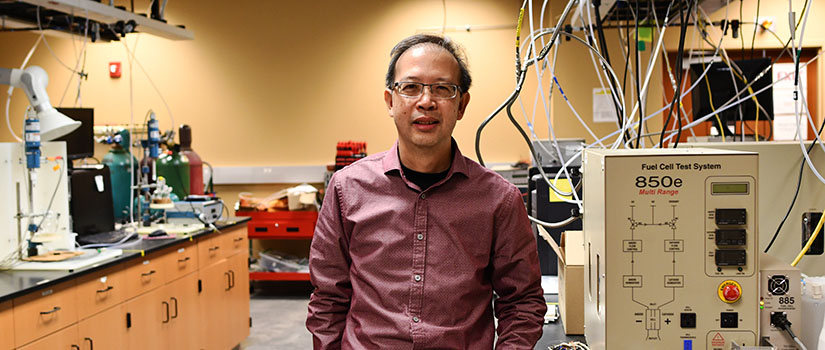According to Research and Markets, the global ethylene demand is expected to research 202 million metric tons by 2026. A key building block in industry, ethylene is a top five chemical in annual production and the second-highest energy consuming chemical per weight.
Ethylene is typically manufactured at centralized and energy-intensive facilities. But these are often inefficient since combustion of fossil fuels are used for heating the reactor and other process streams. The facilities are also not capable of taking advantage of smaller sources of raw materials and energy. Chemical Engineering Research Professor Sirivatch Shimpalee recently began research to develop a different heating process that will decrease costs and improve efficiency.
In December, Shimpalee was awarded $385,000 over three years from the Department of Energy Office of Energy Efficiency and Renewable Energy, Advanced Manufacturing Office for his research, “Thermocatalytic Ethylene Production Using Targeted Radio Frequency Induction Heating.” Chemical Engineering Professor John Regalbuto is a co-principal investigator, while Savannah River National Laboratory (SRNL) is the project manager.
“Ethylene is an important chemical in commercial use, and industry has been looking at new processes that can provide higher efficiency and more profit,” Shimpalee says. “The Advanced Manufacturing Office issued a call that mainly revolved around new technologies.”
The project plans to introduce radio frequency induction heating, which uses a magnetic field to rapidly generate heat directly at a susceptor inside a catalyst. The susceptor material is used since it absorbs electromagnetic energy and converts it to heat. This localized heat is used for the ethane reaction to become ethylene. Shimpalee’s research team will also create multiscale modeling of electromagnetic radio frequency reactors. Finally, they will work with SRNL to design a reactor.
“The goal is to develop a low-cost, integrated process to produce ethylene while significantly reducing energy intensity and operational costs,” Shimpalee says. “It will leverage SRNL’s expertise in electromagnetic radio frequency induction heated thermocatalysis combined with our team’s expertise in novel catalyst design by optimizing the heat input. The process aims to result in highly efficient, ultrafast heating at the catalyst surface.”
A catalyst is required to create the reaction from ethane. Regalbuto, the SmartState Endowed Chair of the Center of Catalysis for Renewable Fuels at the University of South Carolina, will direct the strong electrostatic adsorption deposition method for synthesizing novel catalyst formulations optimized for radio frequency coupling. In this process, the reactor is covered on the outside by radio frequency and passed through the conversion mechanism of ethane to ethylene in the presence of carbon dioxide. The conventional process of producing ethylene uses large-scale catalysis, which requires higher external heating of the reactor and process streams.
“Conventional heating leads to negative factors, such as significant heat loss, reduced energy efficiency, and process stability,” Shimpalee says. “Our catalyst is heating directly using radio frequency induction heating. The focus is on the inside temperature, where the reaction begins when the catalyst particles start to react with all the chemicals. The core of the catalyst is then heated directly to make a very quick reaction. Our goal is to go from 20 degrees to 100 degrees Celsius in 10 seconds. SRNL came up with the idea that we could use the microwave technology by placing it in the reactor and remain inside to maintain the heat.”
Shimpalee’s plan of electromagnetic-coupled heating is a potential solution because it not only has a faster heat transfer and low-bulk temperature, it also precisely heats the catalyst inside the reactor. The advantages of electromagnetic thermocatalytic reactions allow better control of conversion and product distribution, and reduced process footprint. The research aims to advance ethylene production by improving energy efficiency by 50%. By optimizing heat input to the endothermic reaction to improve ethylene low temperature yield, the optimization and improvement in temperature aims to increase the lifetime of a catalyst by 20%, resulting in a 15% decrease in operational costs.
Shimpalee will also determine the outcome of the heat transfer and heat generation once the reaction starts. The modeling process, also known as computational fluid dynamics, will determine how to get the efficiency for the high reaction rate. As director of the college’s Hydrogen and Fuel Cell Center, Shimpalee’s team are experts in electrochemical modeling. They use equations for the transport phenomena and build a simulation for the multi-dimensional modeling to understand the inside of any engineering system.
“My team is involved in the modeling of not only the entire device and system, but the nanoscale of the catalyst design for Dr. Regalbuto to develop. With the three-dimensional entity application, we can scale up or down and use our expertise in equations to develop the model,” Shimpalee says. “Currently, our research team is involved in the nanoscale, microscale and macroscale models to help us size up the small reactor for the lab scale. The modeling tool helps better understand the technology for a large reactor in commercial use.”
In addition to SRNL, the research will be in cooperation with several companies, including Siemens and Induction Food Systems. SRNL and National Renewable Energy Laboratory in Colorado will adopt the modeling. Induction Food Systems, which uses similar electromagnetic heating, will receive the modeling and technology and work on a developing a large reactor.
If the research and a design can demonstrate that ethylene production can be fully electrified though radio frequency induction heated reactor systems, the technology can be implemented immediately to any type of reactor that requires a laboratory.
“We're probably the first ones to do this application,” Shimpalee says. “I love how this is a challenging project because we always do research in hydrogen and fuel cells, but sometimes we have a project like this to energize and encourage one another to explore another research area and learn more.”
